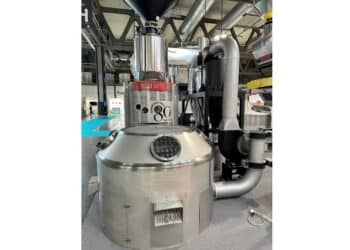Although the sleek exterior of Wilbur Curtis filter brewed coffee equipment might be appealing enough, Marketing Manager Brant Curtis says the true ingenuity of the company’s technological developments might never be noticed by the end user. From single fool-proof connections to exterior temperature probes, Brant explains how the team of engineers at Wilbur Curtis have helped revolutionise filter coffee technology by focusing on the smaller details to improve the user experience. “More than anyone, we place a high emphasis on technology,” says Brant. “We’re known for the unique way we design our equipment.” From its initial founding in 1941 by Brant’s great grandfather, Wilbur Curtis, ingenuity has helped define the company. A former glass salesman for the Silex company, Wilbur invented the disposable glass coffee pot. In the 1980s, the company introduced the Gemini Coffee Brewer, a system that revolutionised the commercial coffee industry by offering the speed of a brewer with the quality of an urn. It enabled servers to create remote coffee stations with removable “satellites” while maintaining the temperature and quality. Brant says that a new technological trajectory was set for Wilbur Curtis in the mid-1990s, when the company sought out a strategic partner in Renau Electronics to assist them in the development of the first ever truly digital coffee brewing system. “Karol Renau asked us for a brewer and together we ideated to define what digital brewing should be. Three months later he came back with the first truly digital coffee brewer,” Brant recalls. “It had the intelligence of a computer to monitor the brewing process.” That digital coffee brewing technology has now entered its fourth generation, with touch screen controls and graphics similar to a smartphone. “There is more technology in our coffee brewers today, than there was in the Apollo 13 spacecraft that landed on the moon,” says Brant. Much of this technology, however, is hidden in the unnoticeable details of the machine. For instance, all Curtis equipment uses a single Molex connector for the controls. Fewer contact points ensures the system is more reliable and can’t be connected incorrectly. “It takes years of foresight and planning for a small detail like that,” says Brant.
Brant points to another “small” detail that required enormous research and development. Curtis brewers don’t have immersed temperature probes because lime is attracted to them. Without regular descaling an immersed probe will often not work correctly once the lime has built up. Mounting a temperature probe on the side of the tank, however, is quite a complex process. Brant explains: “We must ensure the stainless steel used in our tanks has a specific reaction based on temperature. All of our stainless steel is tested for quality compliance with an x-ray gun to test its makeup. Once we confirm the raw material complies to Curtis quality requirements, it’s a matter of calculating an algorithm that provides the temperature inside the tank.” These technological feats take years of work. As a result, Brant says the company is more interested in long-term quality. “We don’t really focus on trends,” he says. “We’ve decided that our business philosophy will be to do a few things exceptionally well.” In its development efforts, Brant says the company doesn’t isolate work within a single department, but rather encourages engineers to listen to customers and look for ways to improve equipment. “We’re not interested in reinventing the wheel,” says Brant. “We’d like to refine it, improve it, and make it last longer.” Efficiency in service is the latest focus for the team, with yet another small detail set to significantly reduce labour and increase coffee quality. In the latest Curtis vacuum dispensers, the Curtis Thermal FreshTrac (TFT) System is included. The TFT features LED lights that flash green when the coffee volume and brew time is within requirements; then red when it needs to be replenished. The lights can be seen from across the room meaning that staff can be alerted immediately when a fresh brew is needed. “A server doesn’t have to leave the counter to check on the coffee. It’s something simple, but if you think about the loss of labour sending someone to constantly check on the coffee in a convenience store or a fast food chain, that’s significant,” says Brant, adding jokingly: “Red and green lights… these are the things that bring spirited discussions in our boardroom meetings.”
Brambati unveils new generation of electric roasters
Italian coffee processing equipment manufacturer Brambati S.p.A. has unveiled its new generation of electric roasters, with a focus on high...




